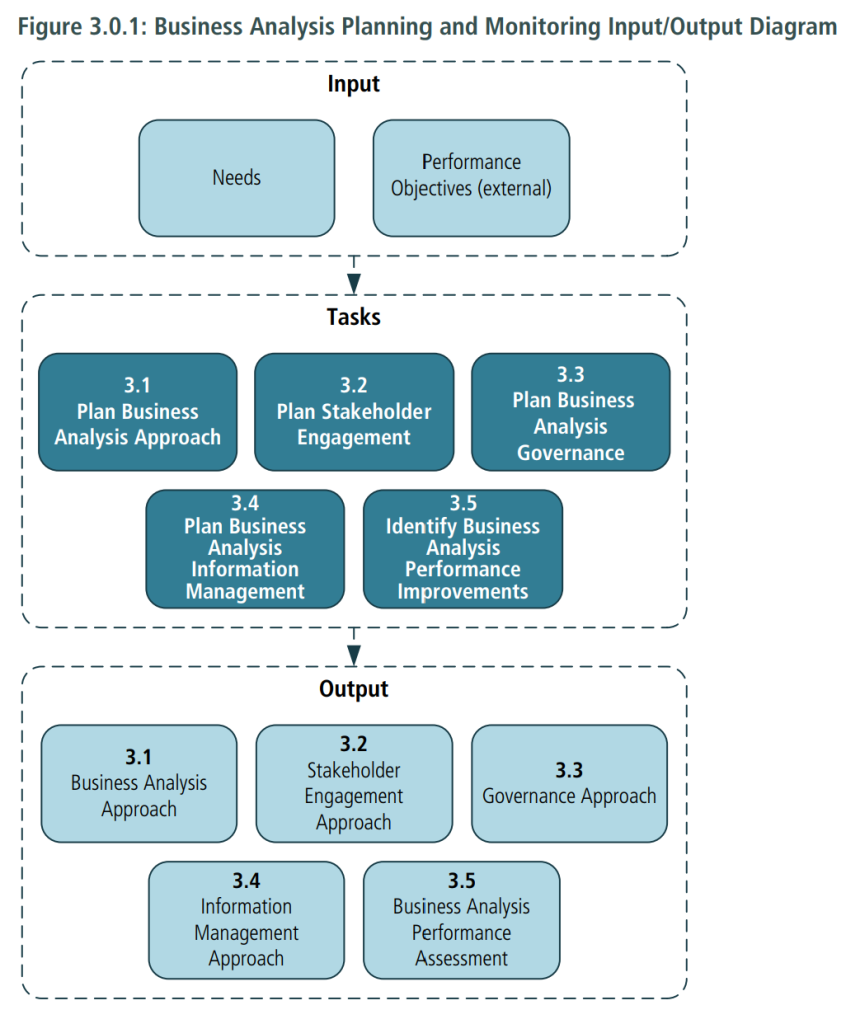The Business Analysis Planning and Monitoring knowledge area tasks organize and coordinate the efforts of business analysts and stakeholders. These tasks produce outputs that are used as key guidelines for the other tasks throughout the BABOK® Guide.
The Business Analysis Planning and Monitoring knowledge area includes the following tasks:
- Plan Business Analysis Approach: describes the planning of business analysis work from creation or selection of a methodology to planning the individual activities, tasks, and deliverables.
- Plan Stakeholder Engagement: describes understanding which stakeholders are relevant to the change, what business analysts need from them, what they need from business analysts, and the best way to collaborate.
- Plan Business Analysis Governance: defines the components of business analysis that are used to support the governance function of the organization. It helps ensure that decisions are made properly and consistently and follows a process that ensures decision makers have the information they need. Examples of this include requirements management, business analysis risk management, and allocation of business analysis resources.
- Plan Business Analysis Information Management: defines how information developed by business analysts (including requirements and designs) is captured, stored, and integrated with other information for long-term use.
- Identify Business Analysis Performance Improvements: describes managing and monitoring how business analysis work is performed to ensure that commitments are met and continuous learning and improvement opportunities are realized.
The Core Concept Model in Business Analysis Planning and Monitoring
The Business Analysis Core Concept Model™ (BACCM™) describes the relationships among the six core concepts. The following table describes the usage and application of each of the core concepts within the context of Business Analysis Planning and Monitoring.
| Core Concept | During Business Analysis Planning and Monitoring, business analysts… |
|---|---|
| Change: the act of transformation in response to a need. | are responsible for determining how changes to business analysis results will be requested and authorized. |
| Need: a problem or opportunity to be addressed. | choose a business analysis approach that provides adequate analysis for the change. |
| Solution: a specific way of satisfying one or more needs in a context. | evaluate if business analysis performance was a key contributor to the successful implementation of a solution. |
| Stakeholder: a group or individual with a relationship to the change, the need, or the solution. |
perform a stakeholder analysis to ensure planning and monitoring activities reflect stakeholder needs and account for stakeholder characteristics. |
| Value: the worth, importance, or usefulness of something to a stakeholder within a context. | conduct performance analysis to ensure business analysis activities continue to produce sufficient value for the stakeholders. |
| Context: the circumstances that influence, are influenced by, and provide understanding of the change. | ensure a complete understanding of the context under analysis in order to develop an efficient business analysis approach. |
Table 3.0.1: The Core Concept Model in Business Analysis Planning and Monitoring

